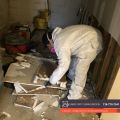The Impact of Mold in Schools on Children's Health


Mold in schools can pose a serious health risk to children. Schools provide a conducive environment for mold growth due to their closed nature, high humidity levels, and frequent water leaks. Mold spores can trigger allergies, respiratory problems, and other health issues in children, which can negatively impact their academic performance and overall well-being.
How Does Mold in Schools Develop?
Mold can grow in schools in various ways. It can develop due to moisture accumulation from leaking roofs, water leaks from pipes, and damp walls. The growth of mold is further facilitated by the use of humidifiers in classrooms, which can lead to excessive humidity levels. Mold spores can also be brought into schools by students and staff members, as they can easily attach themselves to clothing, shoes, and backpacks.
Can Mold in Schools Make Children Sick?
Yes, mold in schools can make children sick. Mold spores can trigger allergic reactions in children, such as sneezing, runny nose, and itchy eyes. Exposure to mold spores can also irritate the respiratory system, leading to symptoms such as coughing, wheezing, and shortness of breath. Children with asthma or other respiratory conditions are particularly susceptible to the negative effects of mold exposure. Furthermore, some types of mold produce mycotoxins, which can cause more severe health issues in children, such as headaches, dizziness, and fatigue.
What are the Symptoms of Mold Exposure in Children?
The symptoms of mold exposure in children can vary depending on the individual and the severity of the exposure. Here are some of the symptoms to look out for:
1. Allergic reactions, such as sneezing, runny nose, and itchy eyes.
2. Respiratory symptoms, such as coughing, wheezing, and shortness of breath.
3. Skin irritation, such as rashes and hives.
4. Fatigue and weakness.
5. Headaches and dizziness.
6. Nausea and vomiting.
What Can Schools Do to Prevent Mold Growth?
Schools can take several steps to prevent mold growth and protect the health of their students. Here are some tips:
1. Regular inspections: Schools should conduct regular inspections of their facilities to identify any areas that are at risk of mold growth, such as those with water leaks or high humidity levels.
2. Fix leaks promptly: Any water leaks in the school should be fixed promptly to prevent moisture accumulation.
3. Keep humidity levels under control: Schools should maintain humidity levels in classrooms and other areas below 60% to prevent mold growth.
4. Improve ventilation: Schools should improve ventilation in classrooms and other areas to help reduce moisture levels and prevent the growth of mold.
5. Clean up mold: If mold is detected in a school, it should be cleaned up immediately using appropriate cleaning solutions and protective equipment.
6. Educate staff and students: Staff and students should be educated on the dangers of mold exposure and how to identify and report any mold growth in the school.
Conclusion
Mold in schools can have serious health implications for children. It is important for schools to take proactive steps to prevent mold growth and protect the health of their students. If you suspect that your child's school may have a mold problem, you should report it to school officials immediately and seek medical attention if your child shows any symptoms of mold exposure.
Bay area mold pros is a leading mold inspection and mold testing company providing quality mold analysis services and helping families & businesses overcome the devastating setbacks caused by mold. Bay Area Mold Pros suggests every homeowner in the San Francisco area should get periodic mold inspections. To schedule our mold inspection & mold testing services visit our website bayareamoldpros.com either email us or fill in the contact form on our website. We can be reached 24/7 at (650)762-6228.








